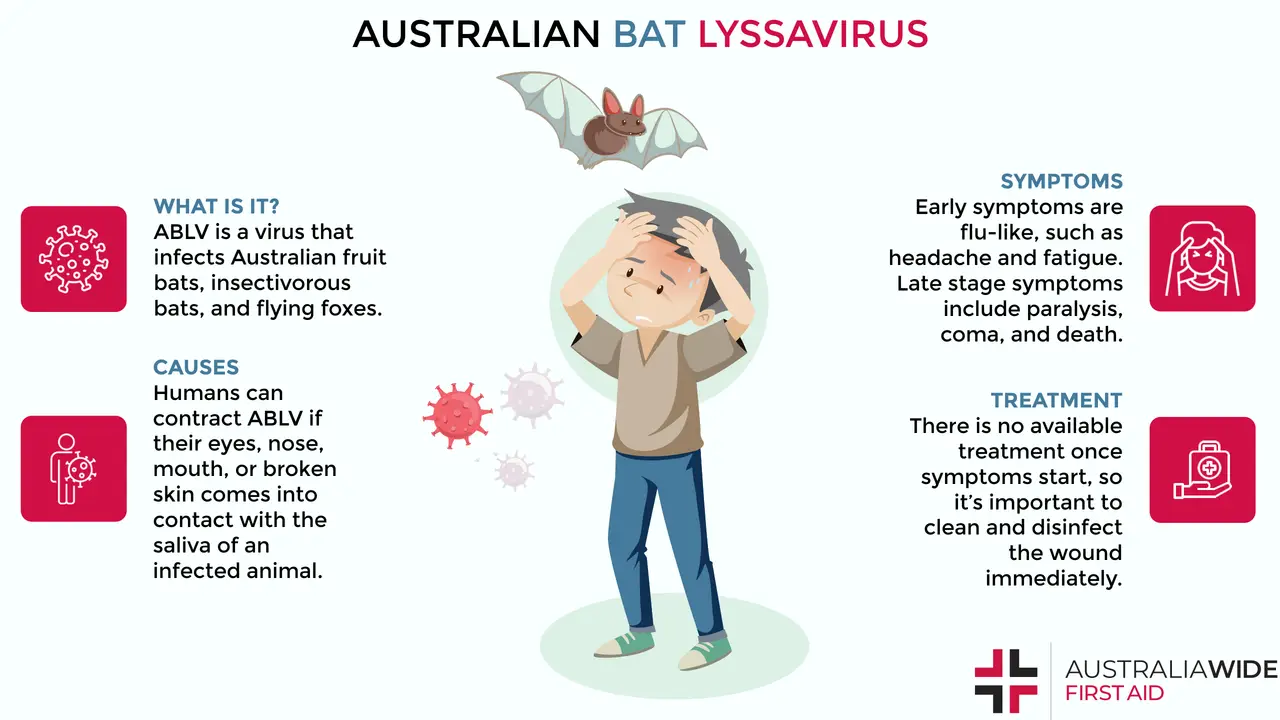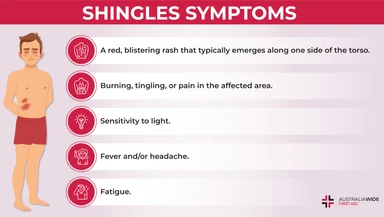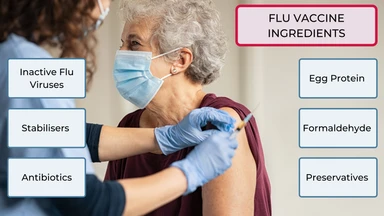Rabies in Australia: The Australian Bat Lyssavirus


The Australian Bat Lyssavirus (ABLV) is transmitted by the saliva of infected animals through bites, scratches or being exposed to their saliva to the eyes, nose, mouth or broken skin. The symptoms of ABLV appear within weeks to years and once it develops, it almost always results in death.
ABLV can be fatal if not treated early before the symptoms appear. There is no treatment available for ABLV once the symptoms start. Today, we are going to cover what this deadly virus is, the causes of it, its history in Australia, its signs and symptoms, first aid treatment and how you can avoid catching it.
The Australian Bat Lyssavirus (ABLV) is a virus that can be transmitted from infected bats to humans through a bite or a scratch and cause serious illness and even death. Till today, there have only been 3 cases where a human was infected by ABLV and all victims died from their infections. ABLV is fatal. Seek medical attention immediately if you are bitten or scratched by a bat in Australia.
Studies have found that ABLV infects all four species of fruit bats and flying foxes in Australia and at least seven species of insectivorous bats. Virus studies suggest that the lyssavirus is widely distributed in Australia. Thus, stay safe and assume that all Australian bats have the potential to carry and spread ABLV.
ABLV is generally transmitted from infected bats to humans through a bite or a scratch. Breaking the skin through a bite directly spreads the virus in the saliva of the bat to the person’s tissues and nerve endings. The virus can also be spread from bat saliva through exposure of mucous membranes such as eyes and nose. Contact or exposure to bat faeces, urine or blood is not considered a risk of ABLV infection as the ABLV virus does not survive outside of the body of the bat for more than a few hours.
Recent surveys conducted showed that less than one percent of wild bat populations carry ABLV. In sick and injured bats, an estimated 7% were found to carry the lyssavirus. However, it must be assumed that any bat (sick, injured or healthy) in Australia could be infectious with ABLV.
Lyssavirus is a group of viruses that is categorised into 14 species. It includes the rabies virus, Australian bat lyssavirus, European bat 2 lyssavirus and others. ABLV is a virus that is closely related to the rabies virus since they belong to the same family of viruses, lyssavirus. The animals in Australia do not have rabies.
ABLV was first discovered in an Australian black flying fox in Queensland in 1996. It was then identified as a lyssavirus, closely related to the common rabies virus found overseas in mostly Philippines, Thailand and Indonesia.
There have been three human cases of ABLV infection reported. All victims were from Queensland and the incidents occurred in 1996, a woman in 1998 and an eight year old boy in 2013. All of them reported suffering from bites and scratches from a bat, and died from their infections.
In May 2013, 2 horses were confirmed to be infected with ABLV in South East Queensland. These were the first ever known cases of ABLV present in an animal other than a bat.
Early symptoms are flu-like:
Later and more serious symptoms:
The time from exposure to the virus to symptoms surfacing varies from weeks to years. Out of the 3 human cases of ABLV infection: one became unwell after 4.5 weeks after being bitten by a bat, another started showing symptoms around 8 weeks after a scratch from a bat and the last one only became ill after a bite from a bat more than 2 years later.
Once the symptoms develop, ABLV in humans is almost always fatal with close to 100 percent certainty. All the three known cases of ABLV infected humans in Australia have resulted in death. Some paralysis progresses to complete paralysis, then coma and death due to breathing failure. Without intensive care, death is certain within the first seven days of presence of symptoms.
There is no available treatment for ABLV once the symptoms start. Hence, perform immediate first aid and then seek professional help as soon as possible.
The people who handle bats in Australia are at risk of ABLV infection. The best way to avoid ABLV is to stay away from handling bats. If you come across an injured bat, do not handle it yourself. Call the Wildlife Information Rescue and Education Service organisation (WIRES) on 1300 094 737. They have trained staff members who know how to handle bats safely.
If your work requires you to handle bats or if you are travelling to places where you are at risk of getting bitten or scratched by a bat infected with ABLV, getting vaccinated is your best protection. The vaccine is safe and some side effects include headache, sore arm and swelling at the injection site.
Learn how to perform proper First Aid to reduce the transmission of ABLV from a bat bite or scratch. Book a date to learn First Aid with Australia Wide First Aid today!

October 28, 2022
Shingles is a viral infection that can occur in anyone who has had chickenpox. It's most distinct symptom is a painful, blistering rash that occurs on one side of the body. Without prompt treatment, shingles can have life-threatening complications.

August 4, 2022
The Australian Bat Lyssavirus (ABLV) forms part of the same family as the rabies virus. ABLV infects all four species of fruit bats and flying foxes in Australia. In humans, ABLV can cause respiratory difficulties, coma and, in most cases, death.

June 10, 2022
Flu viruses can change their surface structure from one year to the next. As such, new flu vaccines are developed each year. Flu vaccines comprise numerous ingredients that aid their development, purity, and efficacy.